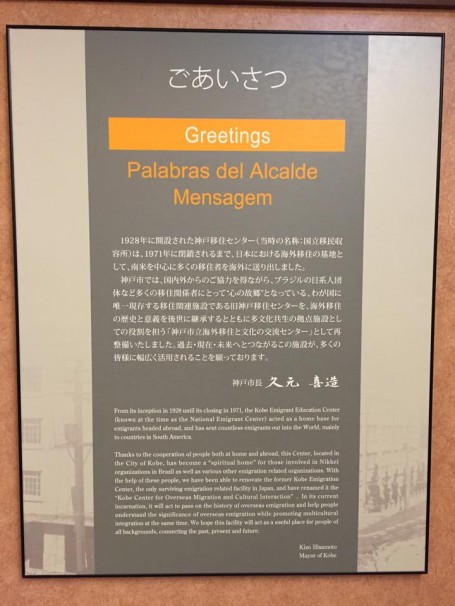By: Joyce Lee
Today June 9 marks the twelfth day of the trip! Despite having a long traveling day yesterday, we were all still excited to experience two great cities of Japan: Kobe and Osaka.
Our experiences in Kobe began at the Kobe Center for Overseas Migration and Cultural Interaction (formerly known as the National Emigrant Center). The site acted as a home base for emigrants before they departed Japan. Today, the center seeks to be both an educator of overseas immigration and a promoter of multicultural integration. For students like me researching minority groups in Japan, the center provided a great introduction about many Japanese who had left for foreign countries such as Brazil and the historical context for why their descendants and other immigrants came to live in Japan today.
Many people living in and outside of Japan are unaware of the diversity of immigrants living in the country. Although Japan is 98% ethnically Japanese, living in Japan are people with ties all around the world. This includes regions like South America, Southeast Asia, China, Europe, North America, and the Korean peninsula.
One of the most inspiring aspects about the Center was that it did more than just educate visitors about the history of emigration from Japan to Latin America. The center pushes visitors to gain an understanding of the past in order to analyze the present and predict future immigration and diversity issues in Japan. For example the center asks visitors to consider how globalization, both from workforce immigration and foreign students staying after graduation to work in Japan, can help create a richer society. It leads visitors to wonder what needs to improve in order to create an environment full of equal and harmonious relationships across all cultural backgrounds. I especially appreciated this aspect of the Center because I have been considering how to fix the mis-perceptions of Koreans living in Japan. Hearing the Center worker’s perspectives on how to mediate these tensions across all different ethnic groups was extremely influential to my research.
One of my favorite exhibits of the Center was one that showed the growth of society’s acceptance. Many events have encouraged mutual understandings across different cultural groups. For example, the Kanto Great Earthquake in 1923 culminated in the massacre of many Koreans and Chinese. This tragic chapter in Japanese history reflects the racism and discrimination that Koreans and Chinese had faced for years up until that point. Nearly 72 years later, another devastating earthquake occurred, but ended in many people coming together to overcome the struggles following the event.
The Center was a great pit stop for our group to gain a greater understanding of Japan’s history and current diversity issues. I’m sure everyone learned a lot about the historical issues shaping Japan today. Our time here in Japan is running short, but visiting insightful sites like these makes me confident that we’ll be making the most of our time here.



